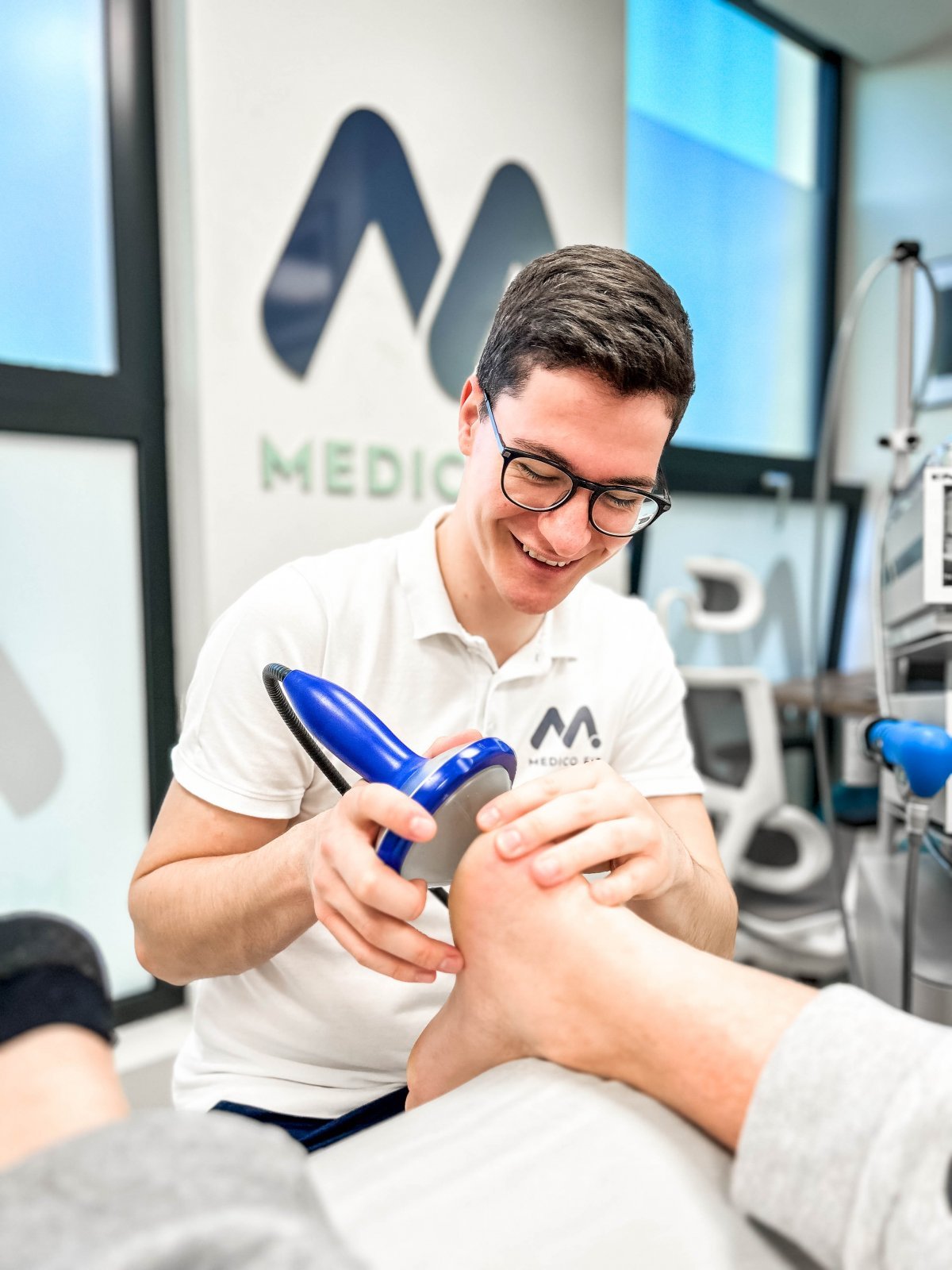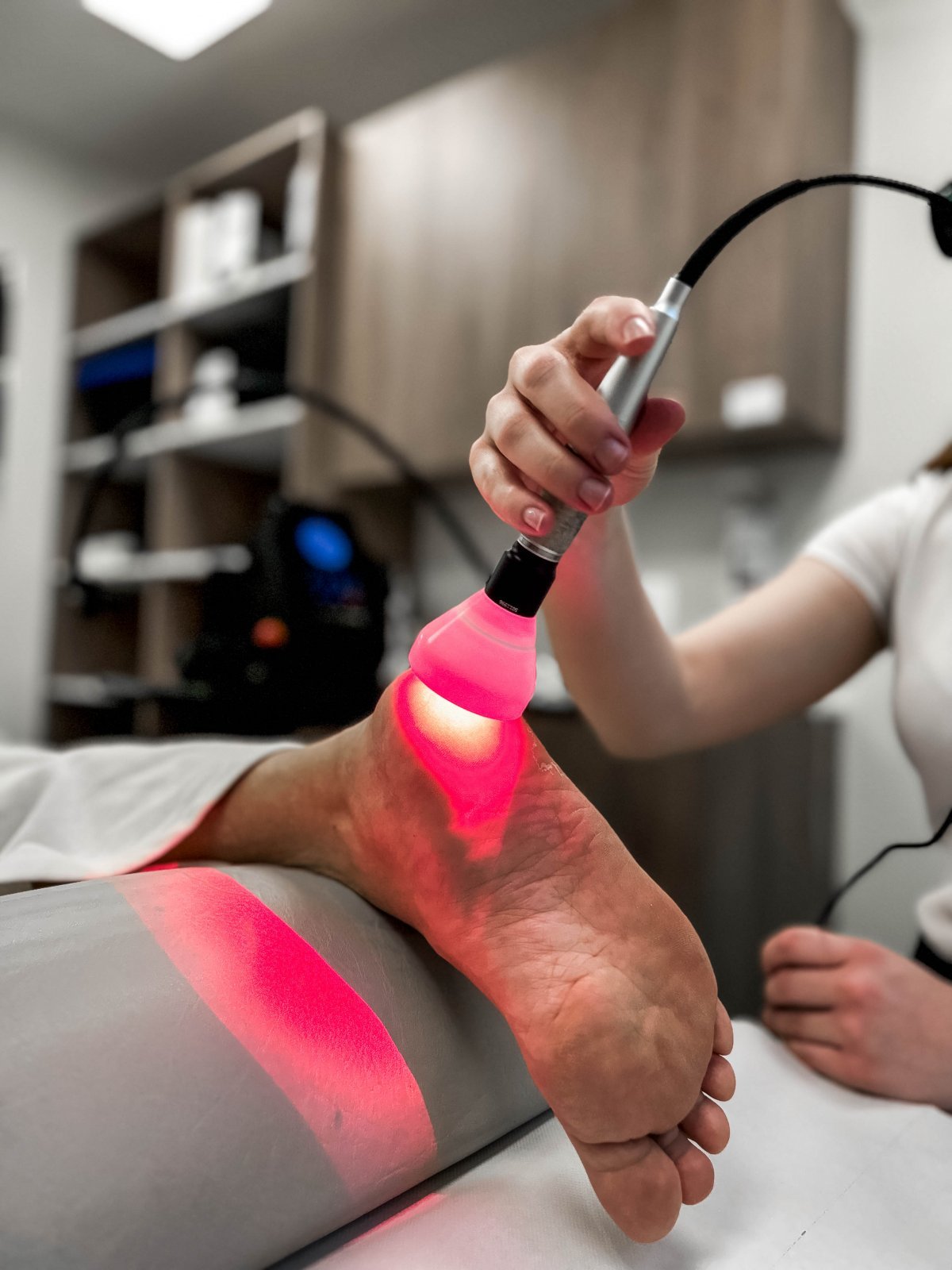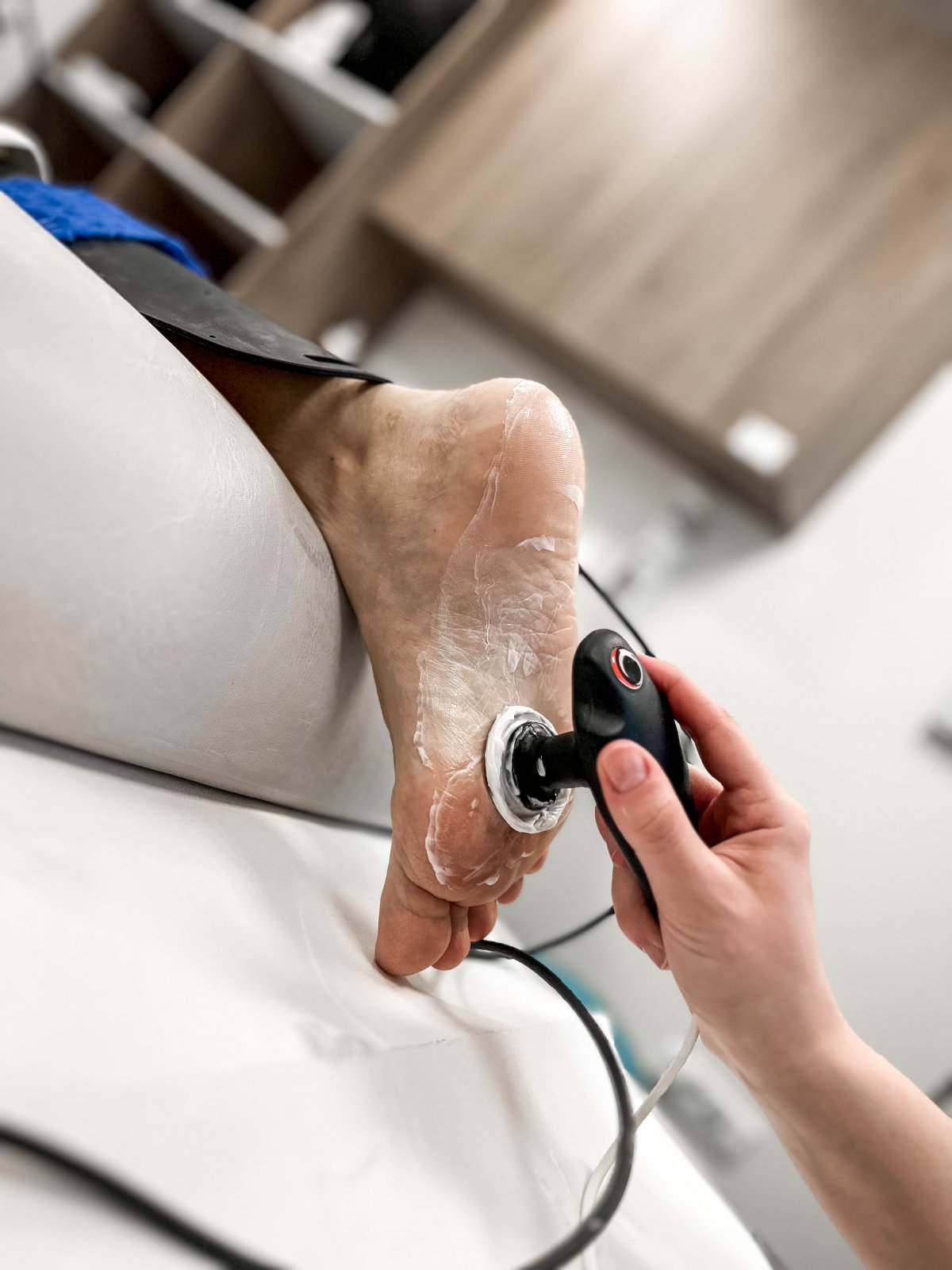Ankle pain is a common problem afflicting many people, regardless of age or physical fitness. According to the World Health Organization, approximately 15% of adults experience ankle pain at least once in their lives. These unpleasant sensations can greatly affect your quality of life, limiting everyday activities and reducing your ability to move.
Inappropriate or inadequate rehabilitation can lead to recurring injuries and long-term limitations in mobility, which can have a major impact on your mobility and overall health.
Ankle pain often develops due to injury, overuse, everyday or sports activities, low load-bearing capacity in the ankle, loss of muscle balance, or other secondary consequences.
Ankle pain manifests itself in the form of sharp pain, which is often accompanied by inflammation, swelling, tenderness, bruising, instability, and a tingling sensation. Often, ankle pain becomes worse when walking.
Modern physiotherapy treatment includes manual therapy, instrumental physiotherapy, and specialised physiotherapy exercises. Read on to learn how MEDICOFIT physiotherapy guides patients from ankle pain to pain-free movement and restores full strength and mobility to your ankle.
At MEDICOFIT clinic, we successfully treat ankle pain caused by:
- ankle instability syndrome,
- sprained ankle,
- ankle fracture,
- posterior ankle impingement,
- Achilles tendinopathy, or
- ruptured Achilles tendon.
WHEN TO OPT FOR MEDICOFIT DIAGNOSTIC THERAPY?
- When ankle pain persists for several days, it is necessary to undergo diagnostic therapy – especially in the event of an injury.
- Ankle pain is accompanied by symptoms such as limited mobility, a feeling of instability, or swelling.
- If you have previously experienced ankle pain and the symptoms are recurring, this means that the condition was not properly treated or that a new injury has occurred.
At MEDICOFIT clinic, we provide patients with scientifically supported specialist physiotherapy, which begins with booking a diagnostic therapy appointment.
Book an appointment for ankle pain treatment
We present the three most common causes of ankle pain.

Ankle sprain
An ankle sprain is one of the most common ankle injuries, resulting from acute injury, repetitive trauma, and functional instability.
An ankle sprain describes a condition where a ligament in the ankle is sprained, and the most commonly affected ligaments are the anterior talofibular ligament (ATFL) and the calcaneofibular ligament (CFL).
Typical symptoms of an ankle sprain include sharp pain, tenderness, swelling, bruising, and the inability to bear full weight on the ankle.
The severity of an ankle sprain depends on the mechanism of injury, the position of the foot during the injury, the rotational force on the ankle, and the stabilising ligament structure.
A diagnostic examination for an ankle sprain assesses the mechanism of injury, any previous ankle injuries, and assesses the patient’s ability to bear weight on the ankle.
Did you know that most people do not visit a physiotherapist after a sprained ankle injury? Did you know that untreated ankle sprains can lead to ankle instability syndrome and faster progression of arthritis?
Modern physiotherapy treatment successfully controls the symptoms of ankle sprains, reducing ankle pain, reducing swelling and inflammation, increasing range of motion, and increasing muscle strength and load-bearing capacity of the ankle.
Ankle instability syndrome
Ankle instability syndrome occurs when a patient experiences repeated ankle sprains that fail to heal properly.
Chronic ankle instability is divided into functional or mechanical instability. It is crucial to determine what type of instability it is, as physiotherapy treatments for the two types differ.
Patients with ankle instability syndrome describe a feeling of pain and instability when under load, prolonged walking, and sudden changes in direction. Swelling and stiffness (limited range of motion) often occur.
If ankle instability syndrome is left untreated, patients find it more difficult to participate in everyday activities (gardening, sports), and walking on uneven terrain becomes almost impossible.
Chronic ankle instability has an extremely negative impact on an individual’s quality of life, so timely diagnosis and physiotherapy treatment are crucial for improving the condition.

Achilles tendinopathy
Achilles tendinopathy is an overuse condition that occurs due to microtraumatic tissue damage that leads to degenerative changes.
The mechanism of injury is due to repetitive use, sports activities, inadequate muscle strength in the shin, insufficient joint mobility in the ankle, knee and hip, inappropriate footwear and inadequate training surfaces.
Patients report pain, which worsens with load, and swelling (pain is proportional to the level of load).
Achilles tendinopathy is divided into a reactive stage, tendon disrepair stage, and degenerative stage.
Achilles tendinopathy is classified according to the site where it develops: insertional tendinopathy (the site of attachment of the calf muscle) and noninsertional tendinopathy, which affects the middle part of a tendon.
Modern physiotherapy treatment eliminates milder reactive forms of Achilles tendinopathy within 10–15 weeks, while the chronic type requires a longer treatment period.
Book an appointment for ankle pain treatment
Comprehensive treatment of ankle pain at MEDICOFIT clinic begins with a diagnostic examination and acute physiotherapy and continues with post-acute kinesiology and post-kinesiology.
Long-term effectiveness of treatment is achieved by active physiotherapy, where patients are actively involved in the treatment process.
The main goal of rehabilitation or treatment is to eliminate the cause of the ankle pain and not just the symptoms that have appeared.
Every patient undergoes a 90-minute individualised treatment, where physiotherapy experts and then kinesiology experts focus individually on the patient.

Diagnostic therapy
The beginning of every successful physiotherapy treatment starts with diagnostic therapy, which provides insight into the functional state of the patient’s body.
The clinical examination begins with an initial interview (in-depth anamnesis), where you describe the course of the disease, the duration of ankle pain, and assess your pain (according to the Visual Analogue Scale – VAS).
The next step in the clinical examination is inspection and palpation, which determines sensitivity to touch, any potential sensory loss, swelling, noticeable muscle atrophy (loss of muscle mass), and skin temperature and colour.
Mobility and arthrokinematics measurements (passive and active mobility is assessed) and muscle strength measurements (the degree of muscle deficit and deviations from norms are determined) are performed.
The biomechanics of walking are assessed (to determine whether your gait has changed due to compensatory movements that the body automatically adopts because it wants to avoid pain).
In chronic ankle instability, ligament laxity (looseness), anatomical shape of the foot (possible presence of flat feet), and ankle proprioception are assessed.
Functional tests are performed to test the exact specific structures in the ankle that are potential causes of your ankle pain.
Diagnostic imaging such as ultrasonography and magnetic resonance imaging (to more accurately define the condition) are usually performed for additional confirmation of the diagnosis (e.g. Achilles tendinopathy).
Based on the diagnostic report, we prepare a treatment programme that is focused on the individual needs of each patient (cause of the injury, symptoms, limitations, and abilities).

Acute physiotherapy
In the primary phase, physiotherapy experts perform symptom control, i.e. reduce ankle pain, reduce inflammation and swelling, and increase range of motion and muscle strength.
In their work, they perform manual therapy, trigger point therapy, joint mobilisation, and myofascial release, which reduce muscle tension, increase range of motion, and reduce pain.
Manual therapy is performed in combination with instrumental physiotherapy, where we use state-of-the-art devices to promote faster tissue healing, improve cellular metabolism, and stimulate the body’s natural self-renewal processes.
- Deep shock waves (performed for Achilles tendinopathy)
- WINTECARE TECAR therapy (performed on the ankle and anterior tibiofibular ligament in ankle sprains)
- SUMMUS high-energy laser (performed on the anterior tibiofibular ligament in ankle sprains)
- HiToP high-tone electrostimulation (for pain reduction)
For example in an ankle sprain, specialised physiotherapy training is performed for:
- improving active ankle mobility,
- strengthening invertor (movement of turning the foot inwards) and evertor muscles (movement of turning the foot outwards),
- strengthening dorsiflexors (movement of pulling the toes towards you) and plantar flexors (movement of pushing the toes towards the ground),
- improving ankle proprioception.
Treatment of Achilles tendinopathy involves specialised physiotherapy training, with ankle plantar flexion exercises in an eccentric regimen or using the “heavy slow resistance” method. A comprehensive treatment approach is important, with progressive strengthening of the tendon’s load-bearing capacity through kinesiotherapy.
DANGERS AND PITFALLS OF DELAYED REHABILITATION

MEDICOFIT specialists
- Delayed rehabilitation increases the risk of developing degenerative changes such as osteoarthritis, leading to permanent damage to the articular cartilage.
- Improper load causes overuse of muscles, tendons, and ligaments, leading to serious soft tissue injuries.
- Delayed rehabilitation leads to invasive surgical procedures to repair injuries that could otherwise be prevented with early and appropriate therapy.
Inadequate or delayed rehabilitation seriously jeopardises an individual’s long-term physical health and is the main culprit for unsuccessful results and permanent movement limitations.

Post-acute kinesiology
After acute physiotherapy treatment, you will be referred to kinesiology experts, who will guide you to excellent physical fitness.
Specialised kinesiology training after ankle pain treatment focuses on strengthening the ankle invertors and evertors in an isotonic regimen, as well as ankle plantarflexors and dorsiflexors.
It is necessary to achieve complete symmetry and normal muscle strength of the shin muscles and improve ankle proprioception.
The injured area is progressively included in a more complex motor training, gradually incorporating basic exercises to strengthen the lower extremities.
Before the completion of treatment, we perform a biomechanical analysis of walking and running, as well as an ankle and foot test battery, which shows your movement abilities.
Post-kinesiology
At MEDICOFIT clinic, we have prepared a special post-kinesiology programme intended for patients who have completed treatment for ankle pain.
The post-kinesiology programme consists of strength training that actively prevents the recurrence of old ankle pain and reduces the likelihood of occurrence of new pain.
Because we believe in a comprehensive treatment, we guide patients from ankle pain to pain-free movement and restore full strength, mobility, and resilience of your ankle.
WHY CHOOSE SPECIALIST PHYSIOTHERAPY TREATMENT?
- We ensure high treatment success and long-term results.
- We greatly reduce the risk of ankle surgery and re-injury!
- We offer state-of-the-art non-invasive treatment methods that provide optimal conditions for complete recovery of your ankle.
Comprehensive treatment at MEDICOFIT clinic is recommended by numerous renowned orthopaedic surgery specialists.















